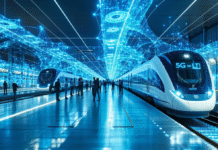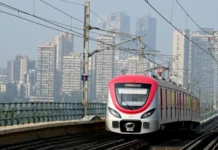Introduction
Nagpur, situated in the central region of India and often referred to as the “Orange City,” ranks as the 13th largest city in India and the third largest in the state of Maharashtra. As per the 2011 census, the population of Nagpur municipality stands at 2,405,665. The city is experiencing substantial population growth due to rapid urbanisation. A report by Oxford Economics projects that Nagpur will be among the five fastest-growing cities in the world from 2019 to 2035, with an estimated average growth rate of 8.41%. This increasing population has led to major challenges, including severe traffic congestion on the roads of the city. Due to this, the city witnessed an urgent demand for an upgraded public transportation infrastructure for the city.
In response to these challenges, a metro system was introduced in Nagpur. However, despite this development, the issue of traffic congestion remained unsolved in the city, as the Nagpur Metro Project primarily provided connectivity within the city but did not address the needs of surrounding towns and regions. To further enhance connectivity in adjacent areas and the outskirts of the city, the Nagpur Broad Gauge Metro Project was proposed. This commuter rail initiative aims to leverage the existing tracks of the Central Railway to establish connectivity between Nagpur and its neighbouring towns.
What is a Broad Gauge Metro?
Broad-Gauge Metro Systems, typically designed to serve both urban and regional areas, operate on broad-gauge tracks. The broader tracks provide stability to trains operating at high speeds and high passenger capacity.
- Track Width: The broad gauge track measures 1,676 mm (5 ft 6 in). This width is greater than the standard gauge (1,435 mm).
- Speed: The broad gauge metro will be capable of operating at a higher speed, with the potential for even higher speeds based on its design capabilities.
Difference between Broad Gauge Metro and Standard Metro System
| Features | Broad Gauge Metro System | Standard Metro System |
| Track gauge | Broad gauge (1,676 mm or 5 ft 6 in). | Standard gauge (1,435 mm or 4 ft 8½in). |
| Purpose | Primarily designed for regional and urban transit. Enhance connectivity between the adjacent towns and outskirt areas. | Designed for urban transit. Enhance connectivity within the cities, focusing on short-distance travel. |
| Integration with other system | Can integrate with existing broad gauge railways for regional connectivity. | Typically operates independently from other rail systems, focusing on urban areas. |

Nagpur Broad Gauge Metro: Redefining Regional Rail Connectivity
Overview
Nagpur Broad Gauge Metro project is a Regional Rapid Transit System ( RRTS) spanning 268.63km with 4 suburban rail lines proposed in 2018 to connect the city with the adjacent towns of Wardha, Katol, Narkhed, Ramtek and Bhandara through a more convenient and advanced railway system.
Estimated cost: Rs 418 Crores
The project will be executed and maintained by the Maha-Metro (Maharashtra Metro Rail Corporation).
DPR & Approvals
- The Detailed Project Report of the Nagpur Broad Gauge Metro project was prepared by the Urban Mass Transit Company (UMTC).
- In November 2019, the Railway Board approved the Detailed Project Report (DPR) of the Nagpur Broad Gauge Metro project
- In October 2020, the Maharashtra State Government’s cabinet approved the DPR of the project.
Funding Mechanism
As per the DPR, the project is estimated to cost Rs 418 Crores. The DPR of the project stated that 70% of the total project cost will be financed through a loan, and 30% will be financed through the Maharashtra and Central Governments. The 50% cost of the project will be utilised to fund the rolling stock procurement. However, there are plans to run the existing Vande Bharat train on the corridors of the Nagpur Broad Gauge Metro. The DPR stated that half of the project cost will be acquired by the modern rolling stock.
Cost Breakdown
- Rolling Stock: Rs. 200 cr
- Depot: Rs. 80 cr
- Station Integration with Nagpur Metro: Rs. 25 cr
- Station upgrades: Rs 23.12 cr
- IT Infrastructure: Rs. 15 cr
- Automatic Fare Collection (AFC) System: Rs. 11.64 cr
- Pre-operative / Admin Expenses: Rs. 4.97 cr
- Taxes: Rs 48 cr
Key Specification
| Authorised Authority | Maharashtra Metro Rail Corporation (Maha Metro). |
| Speed and track | Top speed: 200 kmphOperating speed:160 kmphTrack gauge: Broad Gauge – 1676 mm |
| Rolling Stock | 3 coaches (DT-T-DT) |
| Capacity | 885 passengers |
Route Details
| Operational | 0 km |
| Under construction | 0 km |
| Approved | 0 km |
| Proposed | 268.63 km |
Line 1: Nagpur – Wardha
- Length: 78.8 km
- Estimated Daily Ridership: 5,669
- End-to-End Travel Time: 70 mins
- Number of Stations: 13
- Station Names: Nagpur Junction, Ajni, Khapri, Gumgaon, Bori, Borkhedi, Sindi, Tuljapur, Dahegaon, Seloo Road, Varud, Sewagram, Wardha Junction.
Line-2: Nagpur – Narkhed
- Length: 85.53 km
- Estimated Daily Ridership: 2,616
- End-to-End Travel Time: 75 mins
- Number of Stations: 11
- Station Names: Nagpur Junction, Godhani, Bharatwada, Kalmeshwar, Kohali, Sonkhamb, Metpanjra, Katol, Kalambha, Tinkheda, Narkher Junction
Line-3: Nagpur – Ramtek
- Length: 41.6 km
- Estimated Daily Ridership: 3,929
- End-to-End Travel Time: 60 mins
- Number of Stations: 7
- Station Names: Nagpur Junction, Kalamna, Kamptee, Kanhan Junction, Dumri Khurd, Amdi Halt, Ramtek
Line-4: Nagpur – Bhandara Road
- Length: 62.7 km
- Estimated Daily Ridership: 2,556
- End-to-End Travel Time: 55 mins
- Number of Stations: 8
- Station Names: Nagpur Junction, Kalamna, Kamptee, Kanhan Junction, Chacher, Rewral, Khat, Bhandara Road

Impacts of Nagpur Broad Gauge Metro
1. Enhanced Connectivity to Suburbs: The Nagpur Broad Gauge Metro System aims to enhance connectivity within the city by linking its outskirts to the urban core of Nagpur. The broad-gauge metro system will establish a comprehensive transit network, enabling residents of adjacent towns and areas to experience more convenient and comfortable travel options.
2. Reduced traffic trends Congestion: In 2023, the total number of all vehicle types registered in the city reached an unprecedented level of 2.006 million. Data provided by the Nagpur Regional Transport Office indicates that 74,128 new vehicles, averaging nearly 203 vehicles per day, were introduced to the city’s roads within the same year. This persistent increase in private vehicle registrations has led to worsening traffic congestion across the city. By providing a reliable public transit alternative, the Nagpur Broad Gauge Metro Project will alleviate traffic congestion in the city.
3. Economic Growth: The Nagpur Broad-Gauge Metro will drive economic growth by improving access to industrial zones, creating numerous jobs, and boosting real estate development through Transit-Oriented Development. It will attract businesses to the city outskirts, raise land values, and support commercial infrastructure, positioning Nagpur as a key regional economic hub.
4. Operation Limitations Integration Issue: The Nagpur Broad Gauge Metro project aims to utilise the existing railway tracks, which requires close coordination with the Central Railway to facilitate operational integration. This necessity may complicate the scheduling and maintenance of rolling stock.
5. Delay in Execution: Although the Detailed Project Report (DPR) for the project received approval from the Railway Board in November 2019 and from the Maharashtra Cabinet in October 2020, the construction has still not commenced for the project, which highlights the delays in the execution of the project.
Conclusion
The Nagpur Broad Gauge Metro Project offers multiple benefits for the residents of Nagpur. The project is strategically designed to connect suburban areas and satellite towns with the city’s mainline rail infrastructure. This integration is expected to provide residents of peripheral regions with improved access to educational institutions, employment hubs, and essential services within Nagpur. Despite its strategic significance, the project’s implementation has experienced considerable delays. Although the Maharashtra state government approved the project in 2020, there has been no progress on critical execution activities such as tendering or initiation of civil works. Originally slated for completion by 2025, the current pace of development raises concerns regarding timely delivery. A more proactive and coordinated execution strategy is essential to realise the intended socio-economic and connectivity benefits of the project.






Non-starter. Too many operational conflicts between Maha Metro and Indian Railways. Just introducing air-conditioned MEMUs would have been more than adequate.